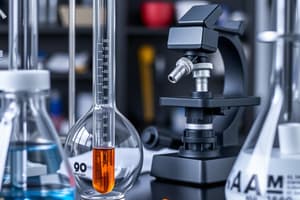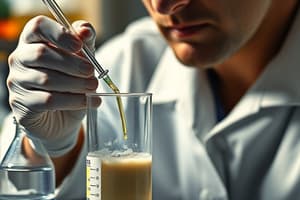Podcast
Questions and Answers
What is the primary purpose of a volumetric flask?
What is the primary purpose of a volumetric flask?
- To measure gas volumes
- To measure mass accurately
- To measure fixed smaller volumes
- To measure fixed larger volumes (correct)
Which of the following instruments provides the highest accuracy for measuring liquid volumes?
Which of the following instruments provides the highest accuracy for measuring liquid volumes?
- Measuring cylinder
- Burette (correct)
- Gas syringe
- Pipette
What is a key factor to avoid parallax error when measuring liquid levels?
What is a key factor to avoid parallax error when measuring liquid levels?
- Ensuring the instrument is on a level surface
- Reading the meniscus from above
- Reading the meniscus at eye level (correct)
- Using a predefined scale for measurement
Which instrument would be most appropriate for measuring a gas volume up to 100 cm³?
Which instrument would be most appropriate for measuring a gas volume up to 100 cm³?
What common error should be considered when using an electronic balance?
What common error should be considered when using an electronic balance?
Flashcards
Pipette
Pipette
A laboratory instrument used to accurately measure specific, fixed volumes of liquid. Example volumes include 1.7 or 10.0 cm³.
Volumetric Flask
Volumetric Flask
A laboratory instrument designed to accurately measure larger, fixed volumes of liquid. Example volume: 100 cm³.
Meniscus
Meniscus
The curved upper surface of a liquid in a measuring instrument. It must be read at eye level to avoid parallax error.
Parallax Error
Parallax Error
Signup and view all the flashcards
Accuracy of Laboratory Instruments
Accuracy of Laboratory Instruments
Signup and view all the flashcards
Study Notes
Measurement Equipment and Techniques
- Electronic Balance: Used for measuring mass with an accuracy of ±0.019 g. Accuracy can vary based on markings.
- Beam Balance: Also measures mass, but accuracy might vary depending on its markings
- Pipette: Delivers a fixed volume accurately. Examples are 2.7, 10.0 mL.
- Volumetric Flask: Used to prepare solutions with a set, precise volume, like 100 cm³.
- Measuring Cylinder: Useful for measuring volumes over a range, typically to the nearest 0.5 cm³.
- Burette: Measures variable volumes, to the nearest 0.05 cm³.
- Gas Syringe: Used to measure gas volumes up to 100 cm³.
Meniscus and Errors
- Meniscus: The curved upper surface of a liquid in a container. It is important to correctly read the meniscus to get an accurate measurement. The meniscus can be either convex or concave.
- Error Avoidance: A technique for avoiding errors in measurement involves positioning your eyes directly on the meniscus to read the volume precisely. This avoids measuring it from different angles, which could lead to errors. Avoiding parallax error (or parallel error is also relevant).
Studying That Suits You
Use AI to generate personalized quizzes and flashcards to suit your learning preferences.




